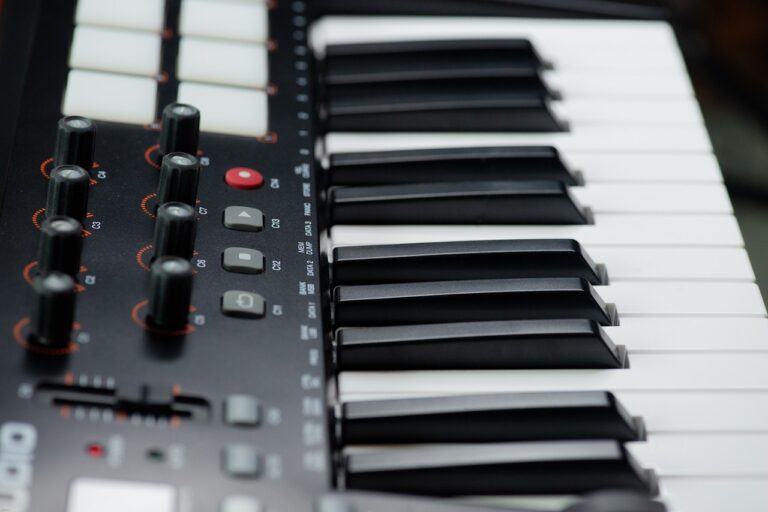MIDI Controller Maintenance: Cleaning, Firmware Updates, and Troubleshooting
Hey there! Having trouble with your MIDI controller? No worries, we've got your back. In this article, we'll walk you through all the essential maintenance tasks to keep your controller in tip-top shape. From giving it a good cleaning to ensuring you have the latest firmware updates, we'll break it down step-by-step so you can take care of your equipment like a pro. And hey, if you run into any common issues along the way, we've got some troubleshooting tips up our sleeves to get you back to making music in a jiffy. So let's dive right in and keep your MIDI controller performing at its absolute best. Sound good? Let's do this!
We are supported by our audience. When you purchase through links on our site, we may earn an affiliate commission, at no extra cost for you. Learn more.
Why MIDI Controller Maintenance Matters
Regularly maintaining your MIDI controller is essential for keeping it in optimal condition and ensuring its longevity. By taking the time to clean your controller after each use, you can prevent dirt and debris from building up and affecting its performance. Dust and grime can accumulate in the buttons, sliders, and knobs, causing them to become unresponsive or sticky. Additionally, firmware updates are crucial for improving the functionality and compatibility of your MIDI controller. Manufacturers often release updates to fix bugs and introduce new features, so it's important to stay up to date. Regular maintenance and updates will not only enhance your controller's performance but also extend its lifespan, ensuring that you can continue to create and innovate with confidence.
Cleaning Your MIDI Controller: Step-by-Step Guide
To clean your MIDI controller, start by gathering the necessary cleaning materials. You will need a microfiber cloth, cotton swabs, rubbing alcohol, and a can of compressed air. Begin by unplugging the controller and turning it off. Use the microfiber cloth to gently wipe down the surface, removing any dust or debris. For hard-to-reach areas, dip a cotton swab in rubbing alcohol and carefully clean the crevices. Avoid using excessive liquid and ensure the controller is completely dry before plugging it back in. To remove stubborn dirt or debris, use the can of compressed air to blow it away. Regular cleaning of your MIDI controller will help maintain its functionality and prolong its lifespan.
The Importance of Firmware Updates for MIDI Controllers
Stay up to date with the latest advancements in your MIDI controller by regularly checking for firmware updates. Firmware updates are essential for keeping your MIDI controller in top shape and ensuring optimal performance. These updates often include bug fixes, new features, and improvements that enhance the functionality and stability of your controller. By installing the latest firmware, you can take advantage of new capabilities and functionalities that may be released by the manufacturer. Firmware updates also address any known issues or bugs that could potentially affect your controller's performance. To check for firmware updates, visit the manufacturer's website or use their designated software to download and install the latest updates. Don't miss out on the opportunity to improve your MIDI controller's performance and unlock new features by neglecting firmware updates. Stay ahead of the game and keep your MIDI controller up to date.
How to Update the Firmware on Your MIDI Controller
Keep your MIDI controller running smoothly by regularly updating its firmware. Firmware updates are essential for ensuring that your controller is equipped with the latest features, bug fixes, and performance enhancements. To update the firmware on your MIDI controller, start by visiting the manufacturer's website and locating the firmware update for your specific model. Download the update file and follow the provided instructions for installation. In most cases, you will need to connect your MIDI controller to your computer using a USB cable and use the manufacturer's firmware update utility to flash the new firmware onto the device. It is crucial to follow the instructions carefully and avoid interrupting the update process to prevent any potential issues. By keeping your MIDI controller's firmware up to date, you can maximize its capabilities and ensure optimal performance.
Troubleshooting Common MIDI Controller Issues
If you're experiencing any issues with your MIDI controller, a helpful first step is to perform a thorough troubleshooting process. Start by checking the physical connections and cables to ensure everything is properly connected. If the issue persists, try connecting the MIDI controller to a different USB port or using a different USB cable. Restarting your computer or the MIDI controller itself can also help resolve common issues. If the problem still persists, updating the firmware of your MIDI controller might be necessary. Visit the manufacturer's website and follow their instructions to download and install the latest firmware version. Additionally, make sure you have the latest drivers installed for your MIDI controller. If none of these steps fix the issue, contacting the manufacturer's support team for further assistance is recommended.
Fixing Unresponsive Keys and Buttons on Your MIDI Controller
To resolve unresponsive keys and buttons on your MIDI controller, perform a thorough cleaning of the device. Dust and debris can accumulate over time, causing the keys and buttons to become sticky or unresponsive. Start by disconnecting the controller from any power source and gently remove the keycaps using a keycap puller or a small flathead screwdriver. Clean the keybed and buttons using compressed air or a soft, lint-free cloth. Be careful not to use any liquid cleaners that could damage the electronics. After cleaning, reassemble the keycaps and test the responsiveness of the keys and buttons. If the issue persists, check for any firmware updates for your MIDI controller and install them according to the manufacturer's instructions. Firmware updates can sometimes fix issues with unresponsive keys and buttons.
Resolving MIDI Connection Problems
To address MIDI connection problems, ensure that all cables are securely connected and properly seated in their respective ports. Loose or improperly connected cables can cause intermittent or no connection at all. Check both ends of the cables to make sure they are firmly plugged in. If the problem persists, try using a different cable to rule out the possibility of a faulty cable. Additionally, check if the MIDI ports on your devices are clean and free from dust or debris. Use compressed air or a soft brush to gently clean the ports. If you are using a USB MIDI interface, make sure it is connected to a working USB port. Restarting your computer or resetting the MIDI device can also help resolve connection issues.
Troubleshooting MIDI Controller Software Compatibility
To troubleshoot MIDI controller software compatibility, check if the controller's firmware is up to date and ensure that it is compatible with the software you are using. Outdated firmware can cause compatibility issues, so it's important to keep it updated. Check the manufacturer's website for any firmware updates and follow their instructions for installation. Additionally, make sure that the software you are using supports the MIDI controller you have. Some software may only be compatible with specific MIDI controllers or require certain drivers to be installed. Consult the software's documentation or website for compatibility information. If you are still experiencing compatibility issues, try using a different software or contacting the manufacturer for further assistance. Remember, keeping your controller's firmware updated and using compatible software will help ensure a seamless and efficient workflow.
Conclusion
Keeping your MIDI controller clean and up to date is crucial for optimal performance. Regular cleaning helps prevent dirt and debris from affecting its functionality. Firmware updates are important to ensure compatibility and access to new features. Troubleshooting common issues like unresponsive keys or connection problems can save you time and frustration. By following these maintenance steps, you can keep your MIDI controller in top shape for seamless music production.







